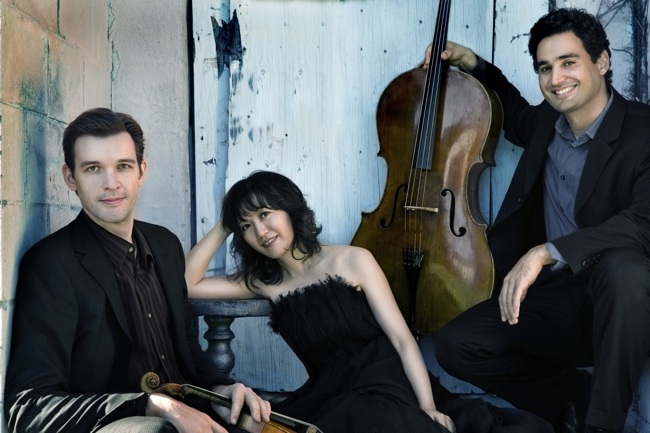A triumphant return to Kohl Mansion.
After a poetic performance at Kohl Mansion in February of 2015, the Horszowski Trio was invited to return to the Great Hall of that Burlingame mansion, and on Sunday, Feb. 12 they again delivered a concert that was by turns light-hearted and powerful.
Composed of pianist Rieko Aizawa, violinist Jesse Mills and cellist Raman Ramakrishnan, this is a threesome as smooth as it gets. Aizawa, though small in stature, is a forceful pianist with a wide color palette, and she was able to give us notes that brooded or sparkled. And there was a weightless quality to her fingers that allowed her to negotiate treacherous passages and make everything feel easy. Ramakrishnan was heavenly in his top register, lyrical and heartfelt, with an ear for timing that unified the three.
And violinist Mills had enough edge to soar over an orchestra, but as a chamber musician he was extraordinarily sensitive and restrained.
They eased into the evening with a work by American composer Arthur Foote, whose lovely trios were too lush for an audience that had passed him by for the leaner experiments of the early twentieth century. But his Piano Trio No. 2 in B-flat Major is thought to be one of his most successful, and the story it tells is unique. Dignified and suave, these musicians made the music positively glow.
After a turn at dignity, they delivered Romantic muscle with big piano attacks and soaring cello lines, and the violin eased in with high notes like drops of tears on a page.
 The Tranquillo was slow and melancholy, then transformed into a minuet that felt so supportive one could have waltzed away an evening, and the Allegro wrapped up with piano octaves and lavish string harmonies and an undertow that felt grandly Russian.
The Tranquillo was slow and melancholy, then transformed into a minuet that felt so supportive one could have waltzed away an evening, and the Allegro wrapped up with piano octaves and lavish string harmonies and an undertow that felt grandly Russian.
After those swirling waters, Leonard Bernstein’s rarely performed Piano Trio was a surprise. Written when he was a student, this was uneven but spectacularly self-assured, a work that presaged greatness. “This piece isn’t performed very often,” explained Mills. “Walter Piston was Bernstein’s composition teacher and assigned a fugue, and when Bernstein sent one in, Piston called it “inappropriate.” So Bernstein turned around and used that fugue three or four times in this piece, showing his sense of humor and confidence at the age of 19!”
This was youthful and experimental, with a cello opening straight out of Saint-Saens’ The Swan, and lots of air and the repetitions of that fugue. But then the piano turned to vivid spatters of notes and the rhythms became frenzied.
The “Tempo di marcia” was so simple it was almost sarcastic, a child’s melody in pizzicato. They eased into slides that were early jazz, and bits of country fiddling, and repeated piano notes like the tolling of a bell in Pictures at an Exhibition. It was sassy and fun.
The following Largo – Allegro vivo began with French and elusive chords, and then bent into lyrical and finally a folksy vein that became spirited, jazzy and gypsy at once. There was some of the lean heat of Bartók here and the pizzazz of 1937 New York. While Bernstein himself called it “juvenilia” (according to the excellent program notes by Kai Christiansen), I’m sure Piston knew he had grabbed a bull by the horns.
The second half of their program was of greatness in its maturity, Franz Schubert’s Piano Trio No 2 in E-flat Major, and a favorite of the repertoire. They delivered this with generous accords and brilliant focus and painted Schubert’s joy in long arcs.
This was dazzling in its simplicity, yet ever-changing, with themes that had the freshness of spring. The funereal quality of the March was a more somber touchstone, and they returned to it unexpectedly to inject darker threads in the joy, and a reminder that Schubert was only 30 or 31 years old when he wrote this and in the final year of a life shortened by terrible illness. When that march metamorphosed from minor into a final major one could well hear the grandeur that beckoned to Schubert from beyond.
Deep stuff, exquisitely played.
Next up on Music at Kohl Mansion is the Bay Area’s beloved Alexander String Quartet, performing two works of polished mastery and a West Coast premiere written expressly for them, on Sunday, March 26 at 7:00 p.m.
—Adam Broner
Photo of the Horszowski Trio, from left: Jesse Mills, Rieko Aizawa and Raman Ramakrishnan; photo by Lisa-Maria Mazzucco.
